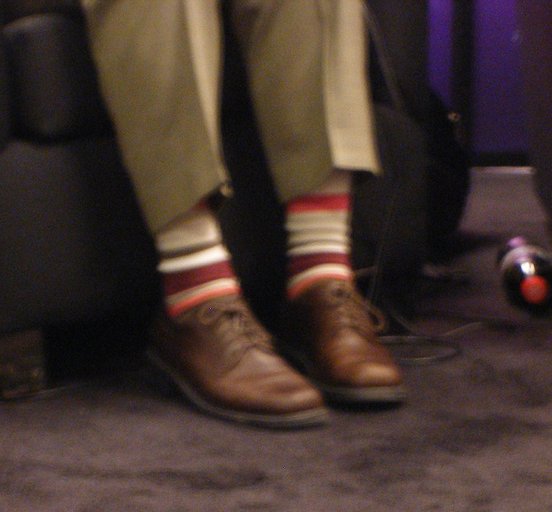Every once in a while Robert Scoble puts down the camera and writes an amazingly thought provoking blog post. Not a perfect post, but one that makes you think about the state of things. Scoble’s comparison of certain VCs to big companies struck a chord with me due a speech I’m working on. I’d like to redefine the problem as a “lack of confidence and/or vision in revenue models” so that it applies to iphone application startups to big companies.
Let’s start an exploration of these issues in more detail:
– There is an almost total lack of imagination regarding potential emerging revenue streams – When I attend search engine conferences, I hear over and over how “63% of transactions occur offline after an online search (comScore 2006).” Tying together that transaction with it’s higher relevancy holds the key to a revenue stream potentially larger than Google’s Adwords product. Having once spent 6 months of my life trying to raise capital for a search advertising concept, I have to agree with Robert that there is lack of willingness to engage in serious funding conversations of this type – until half a dozen other people do it…that’s messed up!
– In large businesses, there is an obsession with basing business cases on expense savings rather than the potential for new revenue streams– Going back to that example above, financial services institutions could play a large role in this. However due to the lack of risk management processes that caused the housing crisis, they are risk adverse at this moment and risk removing themselves from this once in a lifetime opportunity. I saw 4 companies give presentations on their business cases on mobile retail banking and they all focused on the reduction of call center costs! Think about that a second, moving things from a PC to a phone will reduce call center volumes? Highly questionable at best form cost savings perspective, certainly missing the revenue opportunities completely.
– Everything in the world is converging, yet most companies have silos and are hiring specialists (set up for failure) – When banks are trying to become relevant in mobile and mobile is trying to get into advertising and payments, can you afford to hire people with one dimensional skill sets? The answer is no, not if you want to win.
– With increasingly rapid cycle times in technology, competitive benchmarking is becoming less useful – If none of your competitors has made a tough decision to reorganize a department, shift financial resources to new ways of doing things in marketing or customer service, how can you improve via benchmarking? Stated a different way, if your process is broken and all of your competitor’s processes are broken, you can’t possibly create market leadership by benchmarking. You have to hire the best and most brilliant people who hold little if any limiting beliefs and give them the authority to innovate based on what customers want. Serving those needs in the Peter Drucker fashion is the only way to create true market leadership. This does not mean that competitive analysis is dead. It does mean that the benchmarks you need to pay attention to are the breakthroughs regardless of industry.
– Existing legacy cost centers in large corporations are creating barriers to innovation and efficiency both internally and externally – These cost centers prevent reallocation of budgets to adopting usage of superior and more efficient technology or Internet/mobile advertising due to their all or nothing nature – smooth and frequent shifting to most economical resources is the unfortunate rarity. There is a large number of reasons for this and this topic is worthy of a post of it’s own (please submit suggestions). Cost centers make the silo problem worse and hard to solve.
– Traditional management consulting needs to acknowledge proprietary technology and data models as strategic and gain an implementation focus – If you come in for 6 months and never implement anything and nobody does any of the suggestions, your net present value is actually negative.
– We need to take back control of companies to focus on the customer as priority #1 – 5 year plans with a stack of initiatives in year 4 are interesting, but no longer practical. Notice I say take back control. This is the way the world used to work before endless Powerpoint and overly large bureaucracy like 18 month committee approval cycles. In fact Tom Peters stated on February 3, 1998 on Charlie Rose show as saying “I got tired of the McKinsey bureaucracy”
– C-level management and boards of directors treat social media, search marketing and Internet advertising like an island instead of integrating it into one’s culture and redesigning processes from scratch to support it – This is disruptive to companies using these products and companies that provide these products alike due to the lack of growth and monetization. But guess what? You can’t redesign these processes without bringing in people with a combination of skills that include both traditional management and the new tools. Right now we have people at the extremes. This doesn’t work. 🙂
Carolyn Shelby and I will be giving a talk to c-level executives on these an other related subjects this Wednesday at the Gleacher Center in Chicago. You may RSVP here. It is my first in a series of talks I hope to engage the world in over the coming years as we embrace this great challenge together! I need everyone’s help to help shape this vision and create this reality and maybe some famous quotes around the way. It is the furthering of a conversation that started with my appearance discussing these issues on SEO 101 – it starts at the 13:30 mark. Brian Mark said he’d love to see a Search Engine Strategies session on this, we are still working on fulfilling Brian Mark’s dream (24 minute mark).
I’d like to hear others like John Furrier, Fred Wilson, Dick Costolo and Don Dodge to chime in on this issues first chapter…


